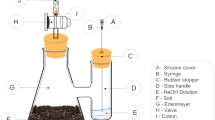Abstract
Immediately after application of chloroalkylene-9-14C to soil (1.32 ppm, based on dry weight of soil in the upper layer of 0 to 10 cm) under outdoor conditions, carrots were sown; in the following year, sugar beets were grown. About 80% of the radioactivity applied volatilized within one vegetation period. Most of the remaining radioactivity was still in the upper soil layer; 0.8% had dispersed to a depth of 40 cm, and 3.3% was taken up by the carrot plants. In the second year, no more decrease of soil residues was observed; uptake by sugar beets was 0.1% of the applied radioactivity.
In the first year, the residues in the upper soil layer consisted of 41% unchanged chloroalkylene-9, 19% soluble metabolites, and 40% unextractable residues; the amount of unextractable residues rose to 68% in the second year. The following conversion products were characterized in the soil extracts: a monohydroxylated dichlorobiphenyl, a monomethoxylated dichlorobiphenyl, and two isomeric monohydroxylated, monoisopropylated dichlorobiphenyls; in carrot roots, a monomethoxylated dichlorobiphenyl was detected. Conjugates occurring in the soil yielded, after acid hydrolysis, a monohydroxylated dichlorobiphenyl among other compounds.
Similar content being viewed by others
References
Anonymous: PCB-substitute is safe for environment. Chem. Eng. News, Dec. 8, p. 7 (1975).
Begum, S., J. P. Lay, W. Klein, and F. Korte: Beiträge zur ökologischen Chemie CIII. Ausscheidung, Speicherung und Verteilung von Chloralkylen-9-14C nach Fütterung an Ratten. Chemosphere4, 241 (1975).
Bidleman, T. F., and C. E. Olney: Chlorinated hydrocarbons in the Sargasso sea atmosphere and surface water. Science183, 516 (1974).
Kotzias, D., W. Klein, and F. Korte: Beiträge zur ökologischen Chemie CXXXV. Photochemisches Verhalten eines PCB-Substituten in wäβriger Lösung und auf Trägermaterial. Chemosphere6, 99 (1977).
Moza, P. N., I. Scheunert, W. Klein, and F. Korte: Contributions to ecological chemistry CXXXVII. Metabolism of chloroalkylene-9-14C in the marsh plant Veronica beccabunga. Chemosphere6, 575(1977).
Moza, P. N., I. Weisgerber, and W. Klein: Fate of 2,2′-dichlorobiphenyl-14C in carrots, sugar beets, and soil under outdoor conditions. J. Agric. Food Chem.24, 881 (1976).
Patent 1, 603, 289; Chlorine-containing dielectric liquids for impregnating metallized paper capacitors. PROGIL S. A., Chem. Abstr.76, 105416 n (1972).
Ruzzo, L. O., G. Sundström, O. Hutzinger, and S. Safe: Environmental chemistry of PCB-replacement compounds II. Photochemical properties of alkylchlorobiphenyls. Chemosphere5, 71 (1976).
Sandrock, K., A. Attar, D. Bieniek, W. Klein and F. Korte: Synthese14C-markierter Umweltchemikalien. J. Labeled Compds. Radiopharm.XIV, 197 (1978).
Author information
Authors and Affiliations
Rights and permissions
About this article
Cite this article
Moza, P.N., Scheunert, I. & Korte, F. Fate of chloroalkylene-9-14C in carrots, sugar beets, and soil under outdoor conditions. Arch. Environ. Contam. Toxicol. 8, 183–189 (1979). https://doi.org/10.1007/BF01056323
Received:
Accepted:
Issue Date:
DOI: https://doi.org/10.1007/BF01056323




